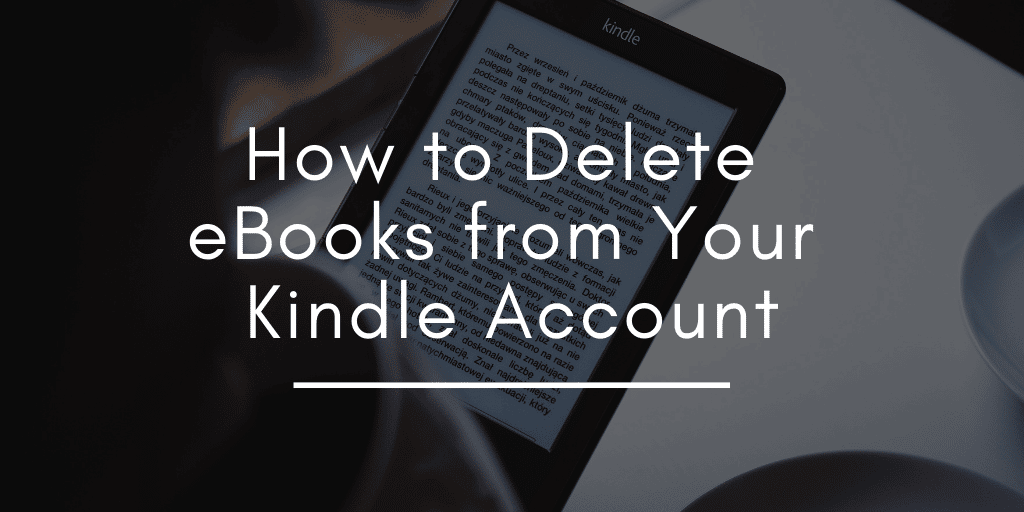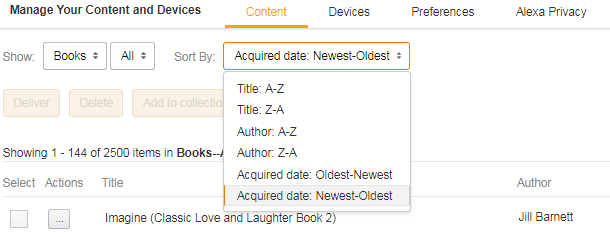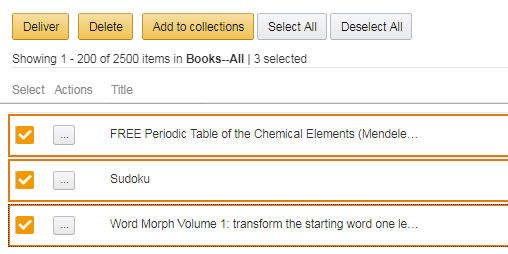How to Delete eBooks from Your Kindle Account on Amazon.com

As you may know, for the past seven years or so I have shared my Kindle account with my mother. She is a voracious reader who is on the mailing list of quite a few authors, and as a result she gets a lot of ARC ebooks. All of those ebooks end up in our Kindle account, and that has really started to be a problem as the number of ebooks approached five digits.
Those ebooks aren’t just taking up space on her device; they also get in the way whenever I try to browse my Kindle library on my Kindle Fire tablet. Her thousands of ebooks are keeping me from finding the ones I want to read.
It’s past time that I weeded my Kindle account. Here’s how I did that.
But before you do anything, please note that this will permanently delete ebooks from your Kindle account. There’s no way back.
First, log in to Amazon and visit the Manage Your Content and Devices page.
This is the page where manage your Kindle library as well as the Kindle apps and devices that are connected to your account. (In another post I’ll explain how to remove devices and apps from this menu, and disconnect them from your account.)
That page defaults to showing only some of your ebooks – the ones you bought from Amazon. It is 2019, but Amazon still continues to treat ebooks acquired elsewhere as second-class content (go figure).
What you will probably want to do next is sort the ebooks by purchase date, title, or author. I hav found that we were most comfortable with deleting the older books.
Next, scroll down the list of books, and once you’ve found one you want to delete, click on the title of the book. You can select multiple ebooks to be deleted at the same time, so do be careful.
Selecting one or more ebooks will activate 3 orange buttons.
Click the delete button. Then, in the confirmation menu, note the warning about permanent deletion, and then click the yes button.
Boom, the ebooks are gone from your account.
I went from close to 10k ebooks to only 2,800 or so, and things are beginning to be a little less cluttered. I’m going to make another pass and delete more ebooks, and after that I’ll probably sort the ebooks into collections. This will make it easier to sort the ebooks by genre, topic, and whether I want to discard or keep them. (I really should have done this years ago.)
So tell me, how many ebooks do you have in your Kindle account right now?





Comments
Paul Durrant April 1, 2019 um 3:29 pm
Perhaps you should consider a separate Amazon account for your mother, and link them via Family Library. Then you only need to share books you think the other will actually like.
Nate Hoffelder April 3, 2019 um 2:48 pm
There is a reason why we haven’t done thta, but it too me a while to remember: My mother likes using the free Prime shipping on my account.
Carmen Webster Buxton April 1, 2019 um 4:17 pm
I have 1,498 Kindle books, as well as 172 "documents" which are a combination of my own and friends' manuscripts and ebooks I got from other sources.
Steve H. April 1, 2019 um 11:30 pm
3000+ All on my Oasis 2.
Mike Hall April 1, 2019 um 6:50 pm
There are 2733 books and documents in my Kindle library, which I share with my wife (we started before Family Library was available) and used to share with my late mother in law (this ignores the 50+ dictionaries and user guides and the pre-orders, a couple of which will turn up in about 15 minutes time).
Not all of them are on our various devices though one of them does have nearly all of them.
I’m feeling a bit smug about your difficulties as I don’t really experience your problem because I’ve been using collections since February 2011. Whenever we get a book it goes into one – or often more – collections. The advantage of the Kindle e-reader software – at least that for the more modern devices – is that you can choose which collections are shown on a device. So for example all of my wife’s books go into her own collections which never show up on my e-readers and if I also want to read the book it also goes into one of my my collections (which she does not see on her e-readers). We also have our own extra collections for things like "books currently being read", "unread science fiction", etc.
The only real problem is that the software – mostly I use Manage your Collections on the PC – whilst fine for putting new books into collections immediately after purchase, is not very good if I want to reorganise the books, say by splitting a collection that has got a bit large (I prefer to keep them to no more than 60 titles). I really would not like to start from scratch though as you are suggesting you might! It was bad enough when I decided to download copies of all the books to create a de-DRMed backup library (at the time you could not remove DRM from KFX files so I wanted awz files that I got by downloading for transfer via USB – something I should have done as I went along and not left it to download some 2000 titles all at once.
DaveMich April 2, 2019 um 12:34 am
Not *that* many, but in the hundreds. Some of the titles were purchased for my son and a few were borrowed for my pre-teen daughter, but not enough to warrant action.
Question for you and others in this situation. What effects does this shared content seem to have on your book recommendations?
(I get the occasional string of scholastic reccos, but nothing too bad)
Mike Hall April 2, 2019 um 3:25 am
Not sure but I do go through sometimes and tell Amazon to ignore certain purchases when making recommendations and this does seem to work; I don’t see any for the stuff I buy my relatives or for my own one off purchases that I’ve said ignore.
Robert Nagle April 2, 2019 um 11:18 am
1. Even though manage content & devices is a well-designed powerful screen, they need to have a way to identify the ebooks with the biggest file size. During the times I have run low of space, it has been hard identifying those ebooks. I have even created a collection for "Large files" so I can (temporarily) remove them from my device if necessary.
2. Wouldn’t it be nice if immediately after making a purchase, you can be given an option to choose a collection to toss it into? It is very frustrating realizing that you always owned an ebook but simply forgot to put it in a collection? (Thank god that the amazon site indicates when you already own the ebook!) At least once a month I have to go through this screen and assign collections for everything.
3. This may sound awfully fussy, but I wish there were some way to keep a simple list with description of all the ebooks I own. (Like a 2-3 sentence summary). I created my own spreadsheet and did this for about 1000 of my ebooks (I have about 3400 on my Kindle account). Still not enough, but it’s a start.
4. Although I have 1300 ebooks on Google Play Books, don’t get me start about that mess. There is no way to organize anything, and it’s hard to guess file sizes for that as well. Also, recently, some uploaded ebooks just don’t show up on my devices — even after I have cleared cache, verified enough storage space, etc. Apparently GPB uses a lot of space on my tablet, like about 3x what it takes on Kindle.
Apparition April 2, 2019 um 12:45 pm
I wonder if Google Play Books uses higher resolution images in their eBooks. That may explain why they take up so much room in comparison. Images in Kindle eBooks tend to have fairly low resolution.
Denise April 2, 2019 um 12:17 pm
Almost 600…but I deleted a bunch last year because I knew I’d never read them or read them again.
Mike Hall April 2, 2019 um 3:09 pm
Robert, re your point (2) this is exactly what I do in Manage your Content and Devices (PC version) whenever I buy an ebook. The only problem arises is when I make the purchase on my Android tablet where the add to collection option does not appear, though when I get back to the PC the zero count for the number of collections the book belongs to reminds me that action is needed.
I don’t think your (3) is being fussy at all, I also have a spreadsheet holding about 1000 descriptions (taken from the books' product pages) and wish there was some easy way to get this information for the rest of my titles. It’s there in the "About this book" data and so presumably in the books' metadata but it cannot easily be extracted. In fact, what I really want is a relational database of my books that could somehow read in all the information needed from my Kindle library (as entering it all manually is just to much work to contemplate).
Mike Hall April 2, 2019 um 5:32 pm
Another comment for Robert: I’ve just found that I need to delete books from a generation 7 Paperwhite so I have room to install the latest software update. Looking at the "Manual Removal – Books" under the memory management option I found it lists books in memory size order (high to low). Just the thing to clear out space as long as one has a late enough specification machine. Our generation 5 Paperwhites (the original small memory version) do not have this software. I just removed 2 dictionaries to temporarily save 114 MB.
Sheri Renee Billings April 2, 2019 um 8:11 pm
Tell me, why, why, why, why it isn’t possible, at this point in Kindle’s lifetime, to mark a book as READ in my Kindle library. I believe it is absolutely ridiculous!
Mehmet Black April 3, 2020 um 6:37 pm
Although I deleted some books on amazon account, I still see those content in my kindle device!!
It is very difficult to delete them one by one.
Could define the way how I can delete the content I dont want in my kindle
DW July 13, 2020 um 6:45 pm
Thank you. Worked for me. It was just finding out how to do.